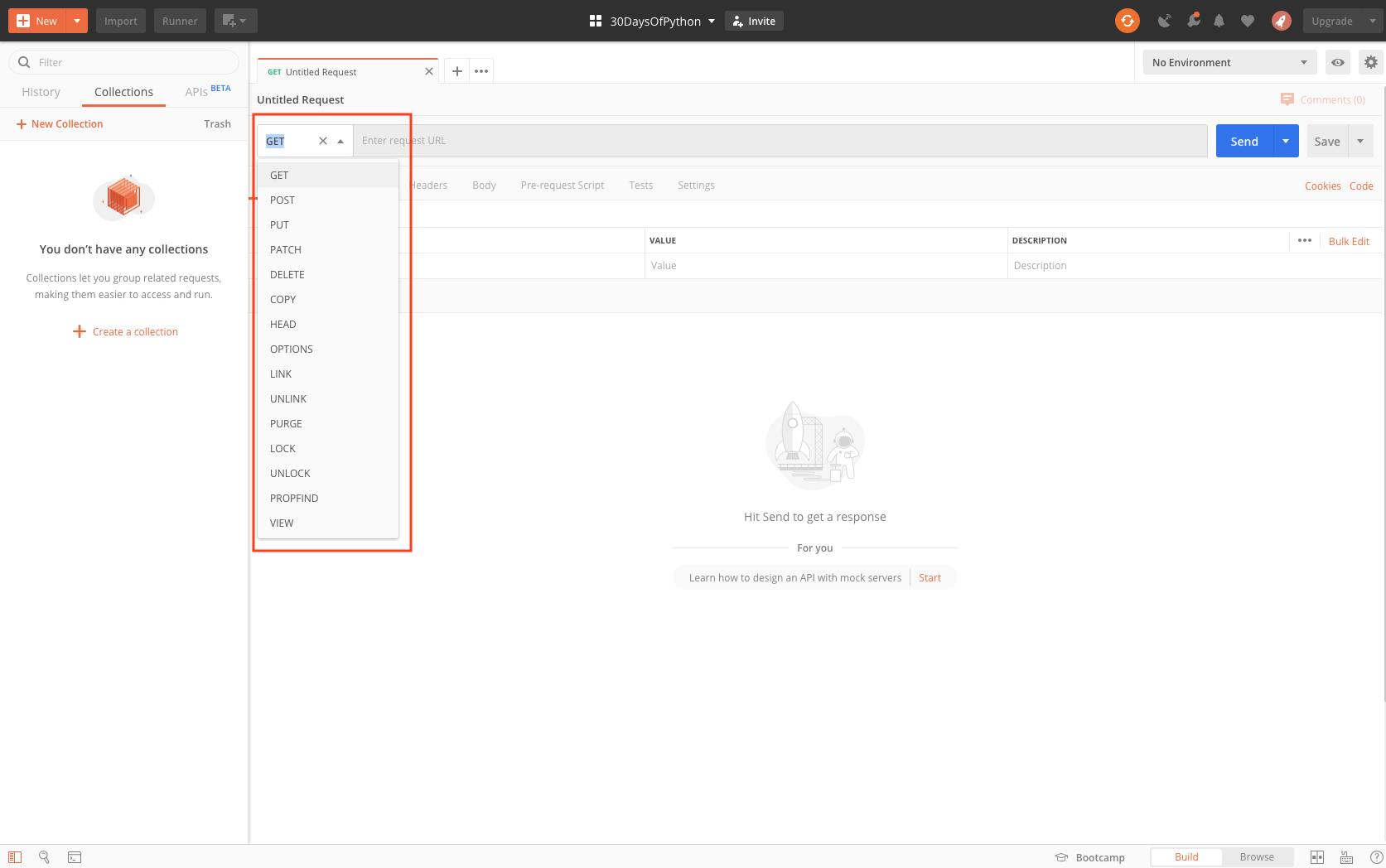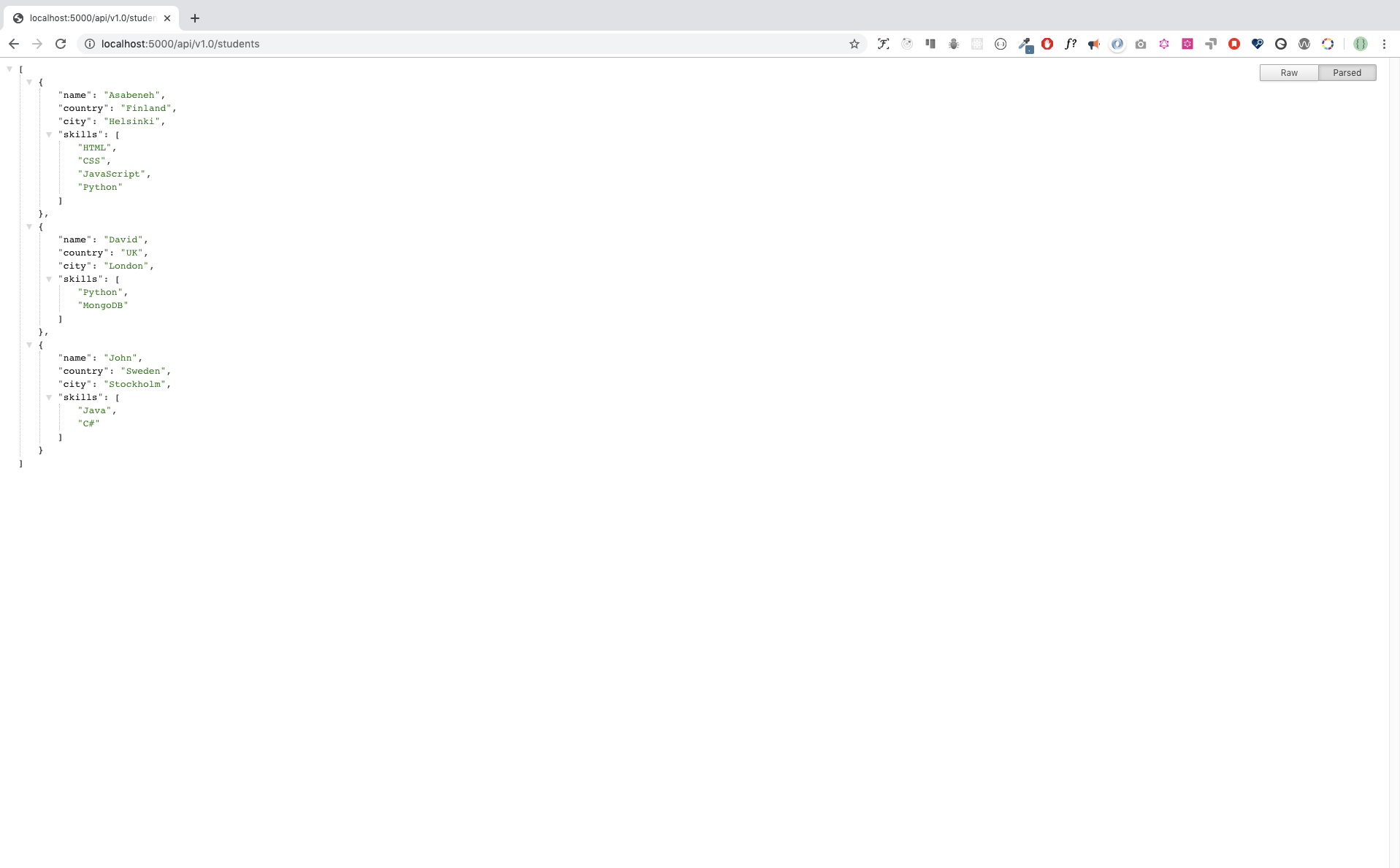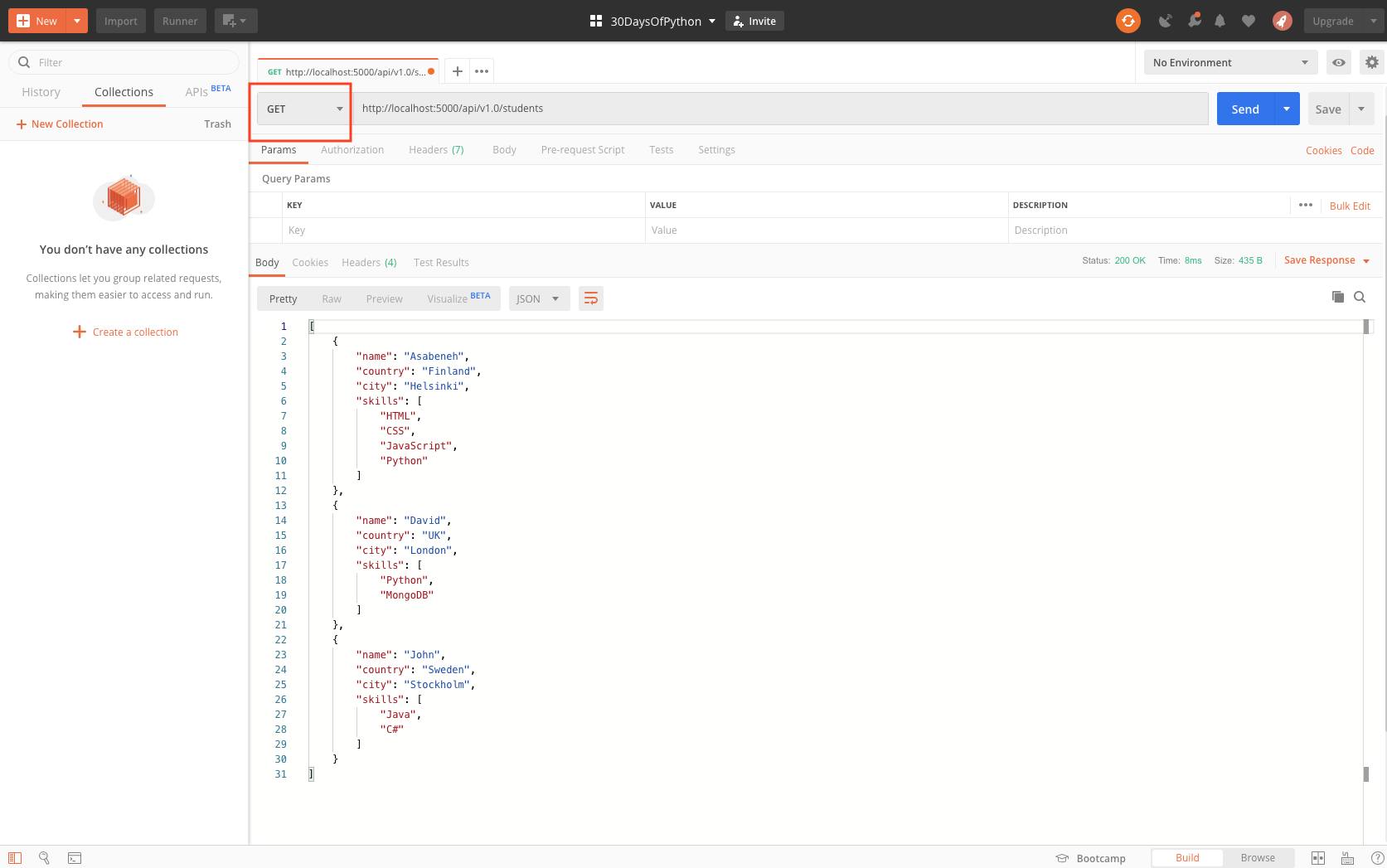第 29 天:构建API¶
第29天¶
构建API¶
在本节中,我们将介绍一个RESTful API,它使用HTTP请求方法来GET、PUT、POST和DELETE数据。
RESTful API是一种应用程序编程接口(API),使用HTTP请求来GET、PUT、POST和DELETE数据。在前几节中,我们学习了Python、Flask和MongoDB。我们将利用我们获得的知识,使用Python Flask和MongoDB开发一个RESTful API。每个具有CRUD(创建、读取、更新、删除)操作的应用程序都有一个API,用于从数据库创建数据、获取数据、更新数据或删除数据。
浏览器只能处理GET请求。因此,我们必须有一个工具,可以帮助我们处理所有请求方法(GET、POST、PUT、DELETE)。
API示例:
- 国家API:https://restcountries.eu/rest/v2/all
- 猫品种API:https://api.thecatapi.com/v1/breeds
Postman是API开发领域非常流行的工具。所以,如果你想完成本节内容,你需要下载Postman。Postman的替代品是Insomnia。

API的结构¶
API端点是一个可以帮助检索、创建、更新或删除资源的URL。结构如下所示: 示例: https://api.twitter.com/1.1/lists/members.json 返回指定列表的成员。只有当经过身份验证的用户拥有指定列表时,才会显示私人列表成员。 公司名称后跟版本,然后是API的目的。 方法: HTTP方法和URL
API使用以下HTTP方法进行对象操作:
让我们构建一个收集关于30DaysOfPython学生信息的API。我们将收集姓名、国家、城市、出生日期、技能和个人简介。
为了实现这个API,我们将使用:
- Postman
- Python
- Flask
- MongoDB
使用GET获取数据¶
在这一步中,让我们使用虚拟数据并将其作为json返回。为了将其作为json返回,我们将使用json模块和Response模块。
# 导入flask
from flask import Flask, Response
import json
app = Flask(__name__)
@app.route('/api/v1.0/students', methods = ['GET'])
def students ():
student_list = [
{
'name':'Asabeneh',
'country':'Finland',
'city':'Helsinki',
'skills':['HTML', 'CSS','JavaScript','Python']
},
{
'name':'David',
'country':'UK',
'city':'London',
'skills':['Python','MongoDB']
},
{
'name':'John',
'country':'Sweden',
'city':'Stockholm',
'skills':['Java','C#']
}
]
return Response(json.dumps(student_list), mimetype='application/json')
if __name__ == '__main__':
# 部署时使用
# 使其在生产和开发环境中都能工作
port = int(os.environ.get("PORT", 5000))
app.run(debug=True, host='0.0.0.0', port=port)
当你在浏览器上请求http://localhost:5000/api/v1.0/students URL时,你将获得以下内容:

当你在Postman上请求http://localhost:5000/api/v1.0/students URL时,你将获得以下内容:

我们不再显示虚拟数据,而是将Flask应用程序与MongoDB连接,并从MongoDB数据库获取数据。
# 导入flask
from flask import Flask, Response
import json
import pymongo
app = Flask(__name__)
#
MONGODB_URI='mongodb+srv://asabeneh:your_password@30daysofpython-twxkr.mongodb.net/test?retryWrites=true&w=majority'
client = pymongo.MongoClient(MONGODB_URI)
db = client['thirty_days_of_python'] # 访问数据库
@app.route('/api/v1.0/students', methods = ['GET'])
def students ():
return Response(json.dumps(student), mimetype='application/json')
if __name__ == '__main__':
# 部署时使用
# 使其在生产和开发环境中都能工作
port = int(os.environ.get("PORT", 5000))
app.run(debug=True, host='0.0.0.0', port=port)
通过连接Flask,我们可以从thirty_days_of_python数据库中获取学生集合数据。
[
{
"_id": {
"$oid": "5df68a21f106fe2d315bbc8b"
},
"name": "Asabeneh",
"country": "Finland",
"city": "Helsinki",
"age": 38
},
{
"_id": {
"$oid": "5df68a23f106fe2d315bbc8c"
},
"name": "David",
"country": "UK",
"city": "London",
"age": 34
},
{
"_id": {
"$oid": "5df68a23f106fe2d315bbc8e"
},
"name": "Sami",
"country": "Finland",
"city": "Helsinki",
"age": 25
}
]
通过ID获取文档¶
我们可以使用ID访问单个文档,让我们使用ID访问Asabeneh。 http://localhost:5000/api/v1.0/students/5df68a21f106fe2d315bbc8b
# 导入flask
from flask import Flask, Response
import json
from bson.objectid import ObjectId
import json
from bson.json_util import dumps
import pymongo
app = Flask(__name__)
#
MONGODB_URI='mongodb+srv://asabeneh:your_password@30daysofpython-twxkr.mongodb.net/test?retryWrites=true&w=majority'
client = pymongo.MongoClient(MONGODB_URI)
db = client['thirty_days_of_python'] # 访问数据库
@app.route('/api/v1.0/students', methods = ['GET'])
def students ():
return Response(json.dumps(student), mimetype='application/json')
@app.route('/api/v1.0/students/<id>', methods = ['GET'])
def single_student (id):
student = db.students.find({'_id':ObjectId(id)})
return Response(dumps(student), mimetype='application/json')
if __name__ == '__main__':
# 部署时使用
# 使其在生产和开发环境中都能工作
port = int(os.environ.get("PORT", 5000))
app.run(debug=True, host='0.0.0.0', port=port)
[
{
"_id": {
"$oid": "5df68a21f106fe2d315bbc8b"
},
"name": "Asabeneh",
"country": "Finland",
"city": "Helsinki",
"age": 38
}
]
使用POST创建数据¶
我们使用POST请求方法创建数据
# 导入flask
from flask import Flask, Response
import json
from bson.objectid import ObjectId
import json
from bson.json_util import dumps
import pymongo
from datetime import datetime
app = Flask(__name__)
#
MONGODB_URI='mongodb+srv://asabeneh:your_password@30daysofpython-twxkr.mongodb.net/test?retryWrites=true&w=majority'
client = pymongo.MongoClient(MONGODB_URI)
db = client['thirty_days_of_python'] # 访问数据库
@app.route('/api/v1.0/students', methods = ['GET'])
def students ():
return Response(json.dumps(student), mimetype='application/json')
@app.route('/api/v1.0/students/<id>', methods = ['GET'])
def single_student (id):
student = db.students.find({'_id':ObjectId(id)})
return Response(dumps(student), mimetype='application/json')
@app.route('/api/v1.0/students', methods = ['POST'])
def create_student ():
name = request.form['name']
country = request.form['country']
city = request.form['city']
skills = request.form['skills'].split(', ')
bio = request.form['bio']
birthyear = request.form['birthyear']
created_at = datetime.now()
student = {
'name': name,
'country': country,
'city': city,
'birthyear': birthyear,
'skills': skills,
'bio': bio,
'created_at': created_at
}
db.students.insert_one(student)
return ;
def update_student (id):
if __name__ == '__main__':
# 部署时使用
# 使其在生产和开发环境中都能工作
port = int(os.environ.get("PORT", 5000))
app.run(debug=True, host='0.0.0.0', port=port)
使用PUT更新¶
# 导入flask
from flask import Flask, Response
import json
from bson.objectid import ObjectId
import json
from bson.json_util import dumps
import pymongo
from datetime import datetime
app = Flask(__name__)
#
MONGODB_URI='mongodb+srv://asabeneh:your_password@30daysofpython-twxkr.mongodb.net/test?retryWrites=true&w=majority'
client = pymongo.MongoClient(MONGODB_URI)
db = client['thirty_days_of_python'] # 访问数据库
@app.route('/api/v1.0/students', methods = ['GET'])
def students ():
return Response(json.dumps(student), mimetype='application/json')
@app.route('/api/v1.0/students/<id>', methods = ['GET'])
def single_student (id):
student = db.students.find({'_id':ObjectId(id)})
return Response(dumps(student), mimetype='application/json')
@app.route('/api/v1.0/students', methods = ['POST'])
def create_student ():
name = request.form['name']
country = request.form['country']
city = request.form['city']
skills = request.form['skills'].split(', ')
bio = request.form['bio']
birthyear = request.form['birthyear']
created_at = datetime.now()
student = {
'name': name,
'country': country,
'city': city,
'birthyear': birthyear,
'skills': skills,
'bio': bio,
'created_at': created_at
}
db.students.insert_one(student)
return
@app.route('/api/v1.0/students/<id>', methods = ['PUT']) # 这个装饰器创建主页路由
def update_student (id):
query = {"_id":ObjectId(id)}
name = request.form['name']
country = request.form['country']
city = request.form['city']
skills = request.form['skills'].split(', ')
bio = request.form['bio']
birthyear = request.form['birthyear']
created_at = datetime.now()
student = {
'name': name,
'country': country,
'city': city,
'birthyear': birthyear,
'skills': skills,
'bio': bio,
'created_at': created_at
}
db.students.update_one(query, student)
# return Response(dumps({"result":"a new student has been created"}), mimetype='application/json')
return
def update_student (id):
if __name__ == '__main__':
# 部署时使用
# 使其在生产和开发环境中都能工作
port = int(os.environ.get("PORT", 5000))
app.run(debug=True, host='0.0.0.0', port=port)
使用Delete删除文档¶
# 导入flask
from flask import Flask, Response
import json
from bson.objectid import ObjectId
import json
from bson.json_util import dumps
import pymongo
from datetime import datetime
app = Flask(__name__)
#
MONGODB_URI='mongodb+srv://asabeneh:your_password@30daysofpython-twxkr.mongodb.net/test?retryWrites=true&w=majority'
client = pymongo.MongoClient(MONGODB_URI)
db = client['thirty_days_of_python'] # 访问数据库
@app.route('/api/v1.0/students', methods = ['GET'])
def students ():
return Response(json.dumps(student), mimetype='application/json')
@app.route('/api/v1.0/students/<id>', methods = ['GET'])
def single_student (id):
student = db.students.find({'_id':ObjectId(id)})
return Response(dumps(student), mimetype='application/json')
@app.route('/api/v1.0/students', methods = ['POST'])
def create_student ():
name = request.form['name']
country = request.form['country']
city = request.form['city']
skills = request.form['skills'].split(', ')
bio = request.form['bio']
birthyear = request.form['birthyear']
created_at = datetime.now()
student = {
'name': name,
'country': country,
'city': city,
'birthyear': birthyear,
'skills': skills,
'bio': bio,
'created_at': created_at
}
db.students.insert_one(student)
return
@app.route('/api/v1.0/students/<id>', methods = ['PUT']) # 这个装饰器创建主页路由
def update_student (id):
query = {"_id":ObjectId(id)}
name = request.form['name']
country = request.form['country']
city = request.form['city']
skills = request.form['skills'].split(', ')
bio = request.form['bio']
birthyear = request.form['birthyear']
created_at = datetime.now()
student = {
'name': name,
'country': country,
'city': city,
'birthyear': birthyear,
'skills': skills,
'bio': bio,
'created_at': created_at
}
db.students.update_one(query, student)
# return Response(dumps({"result":"a new student has been created"}), mimetype='application/json')
return ;
@app.route('/api/v1.0/students/<id>', methods = ['DELETE'])
def delete_student (id):
db.students.delete_one({"_id":ObjectId(id)})
return
if __name__ == '__main__':
# 部署时使用
# 使其在生产和开发环境中都能工作
port = int(os.environ.get("PORT", 5000))
app.run(debug=True, host='0.0.0.0', port=port)
💻 练习:第29天¶
- 实现上述示例并开发这个
🎉 恭喜!🎉